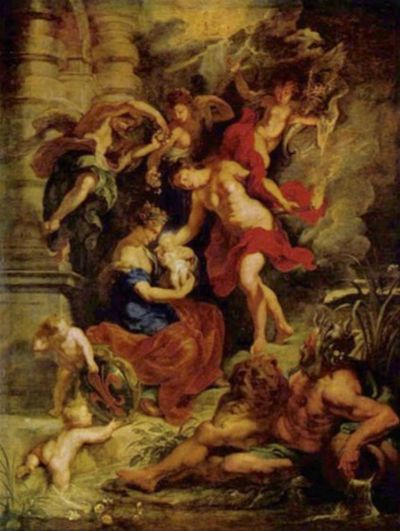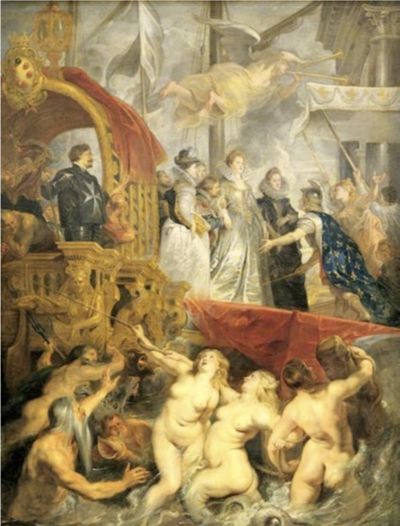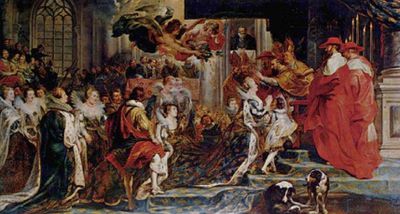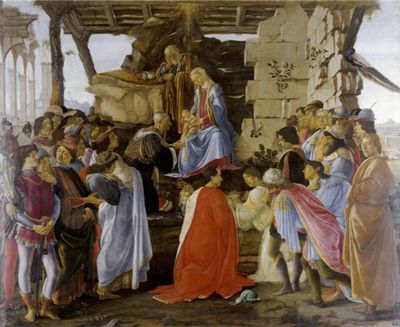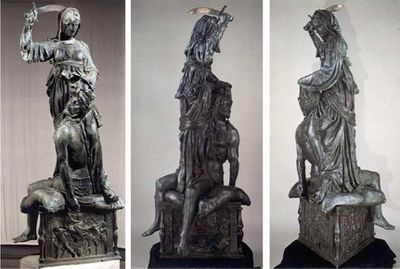Medici patronage and Florentine political and cultural life
The Medici, a family of bankers, merchants, art collectors and patrons, rose to dominate the social, political and cultural life of Florence from the fifteenth to the eighteenth centuries (de Roover, 1963, 142). Due to their close ties to the social, political and economic life of the city, when the Medici commissioned art works, they were aware not only of the honour this bestowed on their own family, but also of the benefit to the city more generally. This means that even private commissions can be interpreted as having an underlying civic, public agenda. The Medici’s artistic patronage not only dominated cultural circles in Florence, but by 1600, Marie de Medici had married the French king, Henry IV. His assassination ten years later in 1610 left her regent of France until her son reached his majority. Marie de Medici continued the trend of Medici art patronage by commissioning the seventeenth century Flemish painter Peter Paul Rubens to paint a series of canvasses for a room in the Luxembourg Palace, or what the queen called the Palais Médicis, between 1622 and 1625 (Lawrence, 1997, 144).
The subject of the paintings, known as the Marie de’ Medici Cycle, were twenty four scenes from the patron’s life, including her birth, arrival in France, coronation, and ultimate ‘triumph’ [Fig.1, 2, 3 and 4.]. It is the only example of the period which shows the large scale, semi public celebration of the life of a contemporary female patron (Lawrence, 1997, 144). The Marie de’ Medici Cycle now hangs in the Musée du Louvre, Paris. The works show the queen surrounded by various groups of mythological figures used symbolically and allegorically in order to associate their virtues with her. The paintings also include recognizable portraits of a number of contemporary figures in order to give a sense of veracity to the scenes. Marie de Medici’s commissioning of the paintings shows an early example of the transfer of an art patronage model from one country to another, as well as giving an example of art patronage being adopted by a new category of patron, in this case a woman, who had not previously had access to commissioning such an extensive work. Such themes tie in with the issues concerning the development of art crowdfunding in the MENA region in that the model has been adopted from Europe and America as well as the fact that it increases the potential for new kinds of patrons to participate in the funding of works of art.
Fig. 1. Peter Paul Rubens, The Birth of the Princess, in Florence on 26 April 1573, Marie de’ Medici Cycle, 1622-1625, Musée du Louvre, Paris. From Louvre. Retrieved 27 April 2015 from http://www.louvre.fr/en/oeuvre-
Fig. 2. Peter Paul Rubens, The Disembarkation at Marseilles, Marie de’ Medici Cycle, 1622-1625, Musée du Louvre, Paris. From Louvre. Retrieved 27 April 2015 from http://www.louvre.fr/en/oeuvre-notices/apotheosis-henri-iv-and-proclamation-regency-marie-de-medicis
Fig. 3. Peter Paul Rubens, The Coronation in Saint-Denis, Marie de’ Medici Cycle, 1622-1625, Musée du Louvre, Paris. From Louvre. Retrieved 27 April 2015 from http://www.louvre.fr/en/oeuvre-notices/apotheosis-henri-iv-and-proclamation-regency-marie-de-medicis
Fig. 4. Peter Paul Rubens, The Triumph of Truth, Marie de’ Medici Cycle, 1622-1625, Musée du Louvre, Paris. From Louvre. Retrieved 27 April 2015 from http://www.louvre.fr/en/oeuvre-notices/apotheosis-henri-iv-and-proclamation-regency-marie-de-medicis
Fifteenth and sixteenth century Medici art patronage in the context of Renaissance Florence can be related to Aristotle’s connection between wealth and the concept of magnificence, an idea which was developed and perpetuated by fifteenth century humanist scholars who looked to the past for cultural, social and philosophical frameworks (Woods, Richardson, and Lymberopoulou, 2007, 57). This meant that the Medici family’s patronage of a diverse range of visual arts including paintings, sculpture and architecture as well as other festive entertainments and the objects associated with them, should be connected with the idea of magnificence, which was linked with lavishing wealth on projects intended to beautify the city through individual, instead of collective, virtues (Kent, 2004, 176). In this sense, Medici patronage of the Renaissance conforms to a completely different, more traditional model of art funding from that promoted by the more contemporary trend towards crowdfunding which, by contrast, replaces the individual with the collective.
In the context of the fifteenth century Florentine republic, the Medici therefore adopted the idea of magnificence as a political tool by which to justify the contemporary inequality in wealth by publically showing themselves to be spending vast sums of money both in praise of God and towards furthering the common good of the city and its citizens (Kent, 2004, 176). Such so-called virtuous projects included financing the construction and decoration of religious buildings, palaces, luxurious costume and festive entertainments. The idea of branding these projects with the Medici coat of arms and recognizable symbols of the family was also justified as a means of identifying the family as the benefactors of the projects and seen as encouraging others to follow the Medici’s example. In this way the idea of magnificence was used to justify the fact that the Medici were so much richer than many other Florentine citizens since they were clearly using their resources to participate in charitable and patriotic act of art patronage which were intended to increase the splendour and beauty of Florence (Woods, Richardson, and Lymberopoulou, 2007, 57).
An example of this can be seen in the incorporation of four generations of family portraits into Sandro Botticelli’s Adoration of the Magi, 1475, for the high altar of the church of Santa Maria Novella, Florence (Cunningham and Reich, 2006, 373) [Fig.5.]. This not only drew attention to the family’s generosity but was also a way in which they sought to encourage those still living to pray for their souls and speed up their progress through purgatory (Woods, Richardson, and Lymberopoulou, 2007, 216). In addition scholars argue that Botticelli’s Primavera, 1478, may have been painted at the time of a Medici wedding in order to decorate the couple’s house [Fig.6.]. The painting is known to contain various symbols not only relating to the humanist scholarship favoured by the Medici, but also to a kind of magnificence which gave the sense of a civic festival to a Medici family wedding (Gardner and Kleiner, 2010, 560).
Fig. 5. Sandro Botticelli, Adoration of the Magi, 1475, Santa Maria Novella, Florence. From Mediateca di Palazzo Medici Riccardi ‘‘Adoration of the Magi’, by Sandro Botticelli.’’ Retrieved 27 April 2015 from http://www.palazzo-medici.it/mediateca/en/schede.php?nome=Adorazione_dei_Magi,_di_Sandro_Botticelli
Fig. 6. Sandro Botticelli, Primavera, 1478, Uffizi Gallery, Florence. From Uffizi Gallery, La Primavera by Botticelli. Retrieved 27 April 2015 from http://www.uffizi.org/artworks/la-primavera-allegory-of-spring-by-sandro-botticelli/
Although the Medici commissioned a wide range of art works in different media, their architecture and sculptures were perhaps most integral to establishing their link with the biopower base of the Florentine republic. This is because buildings and sculptures were most likely to be on public display whereas paintings were usually on display only to members of the household and a few visitors. The Medici family’s position within the republic of Florence meant that while they cultivated an increasingly courtly atmosphere, they were careful to respect certain republican forms of government, largely be claiming that their promotion of their own family was in fact also of benefit to the republic. Their commission of two sculptures by Donatello, David (1430-40) and Judith and Holofernes (1455-60), for the public private space of the courtyard of the Medici palace, demonstrates this idea [Figs.7 and 8.]. The subjects for both sculptures are based on Old Testament biblical heroes. Judith was thought to have rescued her city from a siege by beheading Holofernes, the Assyrian general responsible (Migiel and Schiesari, 1991, 58). David is known as the young shepherd boy who killed the giant Goliath with the help of God (1 Samuel 17:1-58).
Fig. 7. Donatello, David, 1430-40, Bargello, Florence. From Mediateca di Palazzo Medici Riccardi ‘‘David’ by Donatello.’ Retrieved 27 April 2015 from http://www.palazzo-
Fig. 8. Donatello, Judith and Holofernes, 1455-60, Palazzo Vecchio, Florence. From Mediateca di Palazzo Medici Riccardi ‘‘Judith’ by Donatello.’ Retrieved 27 April 2015 from http://www.palazzo-medici.it/mediateca/en/schede.php?nome=Giuditta,_di_Donatello
The figure of David himself was also already established as a symbol of the Florentine republic, and the Medici’s sculpture drew on the precident of Donatello’s marble David a civic emblem from the Palazzo della Signoria (1408-9). As a result they visually linked Medici power with that of the Florentine republic more broadly (Paoletti and Radke, 1997, 268). This idea is also linked to the choice of Donatello to carry out the work since he had worked on various public and civic commissions throughout the city. According to the contemporary Florentine art historian Giorgio Vasari, ‘Cosimo thought so highly of Donatello’s talent that he kept him continually occupied; and in return Donatello loved Cosimo so well that he could understand all he wanted, from the slightest sign, and he never disappointed him’ (Vasari, 1998, 108).
Donatello’s Medici David is one of the first freestanding bronze sculptures of the male nude since classical antiquity, and as such it drew on classical sculptures including the Spinario, that Donatello had studied in Rome (Randolph, 2002, 160). Because of this close association with antiquity Donatello’s sculpture acted to flatter the culture and education of its Medici patrons as well as their guests by playing on their knowledge of antiquity and their recognition of the classical source. The use of bronze, which was both an expensive and novel medium, connected the two sculptures to other public commissions. These include a number of sculptures commissioned by different guilds to adorn the church of Orsanmichele, as well as the baptistery doors. By funding a sculpture in such a new and expensive material, the Medici implied their connections to celebrated and innovative Florentine artistic circles.
In addition, through the sculptures the Medici attempted to connect themselves with the political power base of the city by presenting themselves as upholding republican virtues, an idea which was reconfirmed in inscriptions on both works. The Judith and Holofernes inscription reads, ‘The salvation of the state. Piero de’ Medici son of Cosimo dedicated this statue of a woman both to liberty and to fortitude, whereby the citizens with unvanquished and constant heart might return to the republic’ and ‘Kingdoms fall through luxury, cities rise through virtues. Behold the neck of pride severed by the hand of humility’ (Woods, Richardson, and Lymberopoulou, 2007, 57). The David inscription reads: ‘The victor is whoever defends the fatherland. God crushes the wrath of an enormous foe. Behold! A boy overcame a great tyrant. Conquer, o citizens!’ (Woods, Richardson, and Lymberopoulou, 2007, 57). Such texts would have further conveyed the way that the Medici intended to align themselves with the republic and Florentine civic and political power.
- For more on the Medici Family kindly view the video below :
Video 1 : Documentary on The Medici : Secrets of the most powerful family in the world- retrieved 5th of May from youtube.
Author : Mie Al-Missned
Bibliography
Cunningham, L., & Reich, J. J. (2006). Culture and values: a survey of the humanities. Belmont, CA, Thomson/Wadsworth.
De Roover, R. (1963). The rise and decline of the Medici Bank, 1397-1494. Cambridge, Harvard University Press
Kent, F. W. (2004). Lorenzo de' Medici and the art of magnificence. Baltimore, Johns Hopkins University Press.
Migiel, M., & Schiesari, J. (1991). Refiguring woman: perspectives on gender and the Italian Renaissance. Ithaca, N.Y., Cornell University Press.
Paoletti, J. T., & Radke, G. M. (1997). Art in Renaissance Italy. Upper Saddle River, NJ, Prentice Hall.
Randolph, A. W. B. (2002). Engaging symbols: gender, politics, and public art in fifteenth-century Florence. New Haven, Yale University Press.
Woods, K., Richardson, C. M., & Lymberopolou, A. (2007). Viewing Renaissance art. New Haven, Yale University Press.
Vasari, G., Bondanella, J. C., & Bondanella, P. E. (1998). The lives of the artists. Oxford, Oxford University Press.
Images and Videos
Fig. 1. Peter Paul Rubens, The Birth of the Princess, in Florence on 26 April 1573, Marie de’ Medici Cycle, 1622-1625, Musée du Louvre, Paris. From Louvre. Retrieved 27 April 2015 from http://www.louvre.fr/en/oeuvre-notices/apotheosis-henri-iv-and-proclamation-regency-marie-de-medicis
Fig. 2. Peter Paul Rubens, The Disembarkation at Marseilles, Marie de’ Medici Cycle, 1622-1625, Musée du Louvre, Paris. From Louvre. Retrieved 27 April 2015 from http://www.louvre.fr/en/oeuvre-notices/apotheosis-henri-iv-and-proclamation-regency-marie-de-medicis
Fig. 3. Peter Paul Rubens, The Coronation in Saint-Denis, Marie de’ Medici Cycle, 1622-1625, Musée du Louvre, Paris. From Louvre. Retrieved 27 April 2015 from http://www.louvre.fr/en/oeuvre-notices/apotheosis-henri-iv-and-proclamation-regency-marie-de-medicis
Fig. 4. Peter Paul Rubens, The Triumph of Truth, Marie de’ Medici Cycle, 1622-1625, Musée du Louvre, Paris. From Louvre. Retrieved 27 April 2015 from http://www.louvre.fr/en/oeuvre-notices/apotheosis-henri-iv-and-proclamation-regency-marie-de-medicis
Fig. 5. Sandro Botticelli, Adoration of the Magi, 1475, Santa Maria Novella, Florence. From Mediateca di Palazzo Medici Riccardi ‘‘Adoration of the Magi’, by Sandro Botticelli.’’ Retrieved 27 April 2015 from http://www.palazzo-medici.it/mediateca/en/schede.php?nome=Adorazione_dei_Magi,_di_Sandro_Botticelli
Fig. 6. Sandro Botticelli, Primavera, 1478, Uffizi Gallery, Florence. From Uffizi Gallery, La Primavera by Botticelli. Retrieved 27 April 2015 from http://www.uffizi.org/artworks/la-primavera-allegory-of-spring-by-sandro-botticelli/
Fig. 7. Donatello, David, 1430-40, Bargello, Florence. From Mediateca di Palazzo Medici Riccardi ‘‘David’ by Donatello.’ Retrieved 27 April 2015 from http://www.palazzo-medici.it/mediateca/en/schede.php?nome=David_di_Donatello
Fig. 8. Donatello, Judith and Holofernes, 1455-60, Palazzo Vecchio, Florence. From Mediateca di Palazzo Medici Riccardi ‘‘Judith’ by Donatello.’ Retrieved 27 April 2015 from http://www.palazzo-medici.it/mediateca/en/schede.php?nome=Giuditta,_di_Donatello
Video 1. Documentary : The Medici Secrets of the most powerful family in the world- retrieved on the 5th of May 2015 from https://www.youtube.com/watch?v=x-pC3VZsn4g
